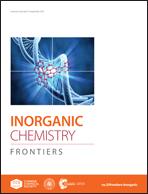Cobalt nanoparticles encapsulated in a nitrogen and oxygen dual-doped carbon matrix as high-performance microwave absorbers†
Abstract
Superfluous electromagnetic (EM) waves as a new type of pollution have severely imperiled our life and working environment. Microwave absorption materials (MAMs) are reliable absorbers owing to their efficient EM energy dissipation ability. The challenge to develop high-performance MAMs is to find magnetic and dielectric composites. In this work, a facile in situ carbothermal reduction method was carried out to design Co nanoparticles encapsulated in N and O dual-doped carbon (Co@NOC) composites. The Co@NOC exhibited a high reflective loss value of −48.9 dB and an effective absorption bandwidth of 14.96 GHz in the range of 3.04–18.00 GHz. The enhanced MA properties could be attributed to magnetic loss (eddy current effect and natural resonance), diversified dielectric loss (conductivity loss, and dipole and interfacial polarizations), and favorable impedance matching performance. In addition, N and O substitutions as dipolar sites were greatly beneficial to enhancing the dipole polarization, leading to enhanced MA properties.



 Please wait while we load your content...
Please wait while we load your content...